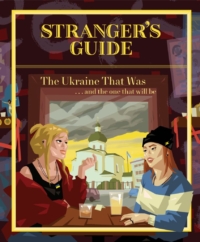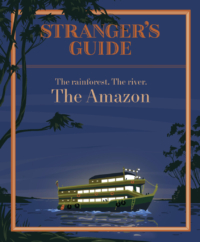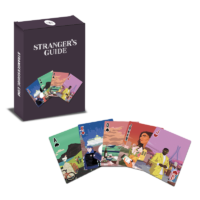
How would you like to travel to exotic places?
And learn a lot about social conditions in those exotic places?
Without leaning your home?
And get a coffee table book four times a year (at least if you aren’t a digital native)?
If you answered even two of those questions in the affirmative, have I got a deal for you!
A Stranger’s Introduction
In the year 1 BC (before COVID), I attended my fiftieth college reunion at Oberlin. After the keynote dinner, my friend Ron Rapoport was passing out copies of a new magazine, Stranger’s Guide like, I imagine, our fathers handed out cigars to everyone they know on the days we were born.
Since Ron is one of the more unusual people I know, I asked him why he was doing it, and he said that it was his daughter Abby’s new project. It turns out that Abby and her friend Kira Brunner Don had started a new magazine that was sort of about travel and sort of about politics and sort of about sports and sort of about LGBTQ+ issues and soft of about youth culture and ….
I had met and liked Abby when she was in junior high school when the whole Rapoport clan came to visit Search for Common Ground. I hadn’t seen her since then, but given the quirky nature (I am understating things here) of her parents and grandparent, I took an issue back to our room. That night, I devoured the issue he gave with my wife, and we talked again the next day. He then asked if I’d be willing to talk with Abby about the magazine. I, of course, agreed, and she and I now meet weekly to talk about the future of the magazine and what we could do together just about every week.
A Stranger’s Magazine
It goes without saying that 2019 was not the best time to launch any magazine. And, given what happened in 2020, it also turned out not to be the best time to launch a magazine about travel in particular.

But Stranger’s Guide suggests that there still is a place for quality print and online journalism.
It has now published seventeen quarterly “guides” that cover places as different as Tehran, Lagos, Ukraine, and, most recently, Chicago. Three issues a year deal some place outside the United States; the fourth is dedicated to some place or thing American. Each issue is chock full of insightful stories and stunning photographs that take you to that place in ways that defy whatever stereotypes you might have about a travel magazine. It is a visual delight because it is brilliantly designed from its cover art down to the quality of the paper it is printed on.
It is so good that it won National Magazine Awards both for its content and its photography in 2022 and 2023.

At least eighty percent of the material is created by local journalists and photographers. Most of them are newcomers trying to make their marks, but recent issues have had original articles by Wole Soyinka and Scott Simon (on Wrigley Field, no less).
Each issue tries to give the reader a feel for the place by including material on youth, the arts, the LGBTQ+ community, sports, and whatever else grabs the attention of the magazine’s staff and the team they assemble to put each issue together.
Thus, the Chicago issue not only gives you insights into Wrigley Field’s place in the city’s life which you probably had thought about before. But what about the gang that tried to compete with Al Capone’s? Or the condiments and spices that make its food unique? Or stepping dance moves in its African-American community? Or an attempt to begin healing the trauma that comes from gun violence through the art of glass blowing?
Then there are the tidbits. Did you know that the word Chicago probably came from the Algonquin words for either striped skunk or onion? Or that the city has more miles of public beaches than Los Angeles? Or about the predatory practices of the Lincoln Towing Service which primarily “serves” people of color?
A Stranger’s Deal
And as of last month, Stranger’s Guide is even easier to get. It is now on Substack.

There is a free version that includes some of each guide’s content as well as its weekly newsletter which is, itself a delight to read.
The entry level paid subscription at $6 a month or $60 a year is a bargain. It gives you electronic access to all the material in the current and past guides. You won’t get the delightful tactile experience of reading each issue before it literally ends up on my coffee table (which no one outside my family has seen since the pandemic began, of course).
If you want the print edition and more, you can become an aptly named fellow traveler.
A Strange Attractor
I’m working with Abby and Kira because I’m convinced that Stranger’s Guide can be an integral part of the peacebuilding and the broader social change communities I work in. Sometimes, the fit is obvious, as it was with the Ukraine issue which came out earlier this year and casts that troubled country in a different, insightful, and uplifting light.
More generally, I’m working with them to turn the magazine into what complexity scientists call a strange attractor which can best be understood here as something whose existence helps shape a seemingly chaotic system by absorbing more and more of its “energy” in new and constructive ways.
Thus, we’ve begun introducing Stranger’s Guide to Alliance for Peacebuilding and Zebras Unite members in ways that both help those organizations do their work and provides material for the magazine to cover. We have been talking about doing specialized print or on-line only guides for specific places, products, or problems.
And now that it is available more easily via Substack, you can become part of what the complexity nerds call an emerging system.
A Strange Gift
Now that it is so easy to access, my chronic gift giving problem is solved. I hate stores. I always put off my holiday shopping until the last minute. Now, I have the perfect gift at the perfect price point.
Everyone on my list will now be getting a digital subscription to the magazine.
I assume that if they want the coffee table experience, they can take care of that themselves.
 Stranger Coming Attractions
Stranger Coming Attractions
Abby and I use our time together talking about themes that future issues could cover. The twentieth issue later this year will probably bring together its best material so far on conflict and its resolution. There could well be issues on Australia, Singapore, or Italy which would include articles on or about the kinds of people I work with. And, I plan to include Stranger’s Guide in my efforts to “connect the dots” among the diverse movements for social change in this country and feature it in the whole-lot-more section of the book I’m writing with Patricia Shafer, Peace is a Verb … and a Whole Lot More.
The views and opinions expressed in this article are those of the author and do not necessarily reflect the official policy or position of the Alliance for Peacebuilding or its members.
